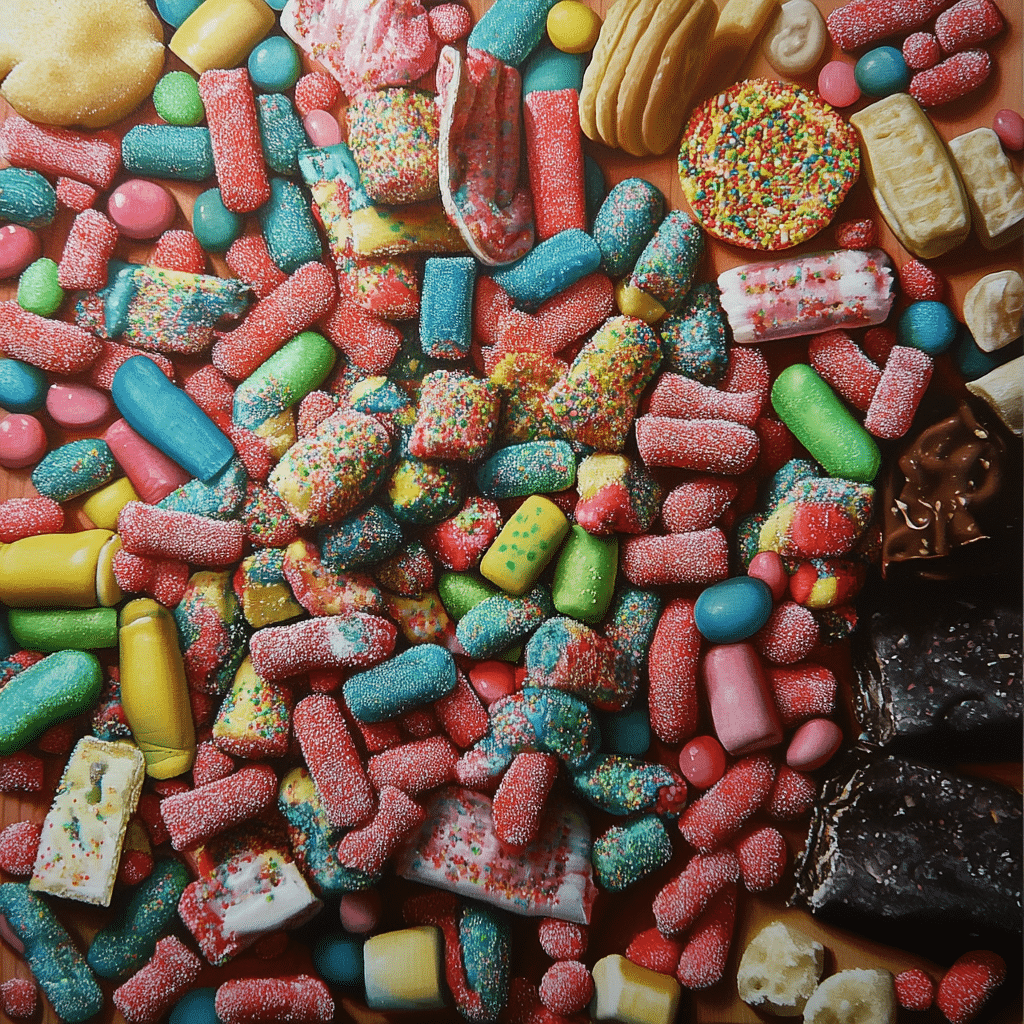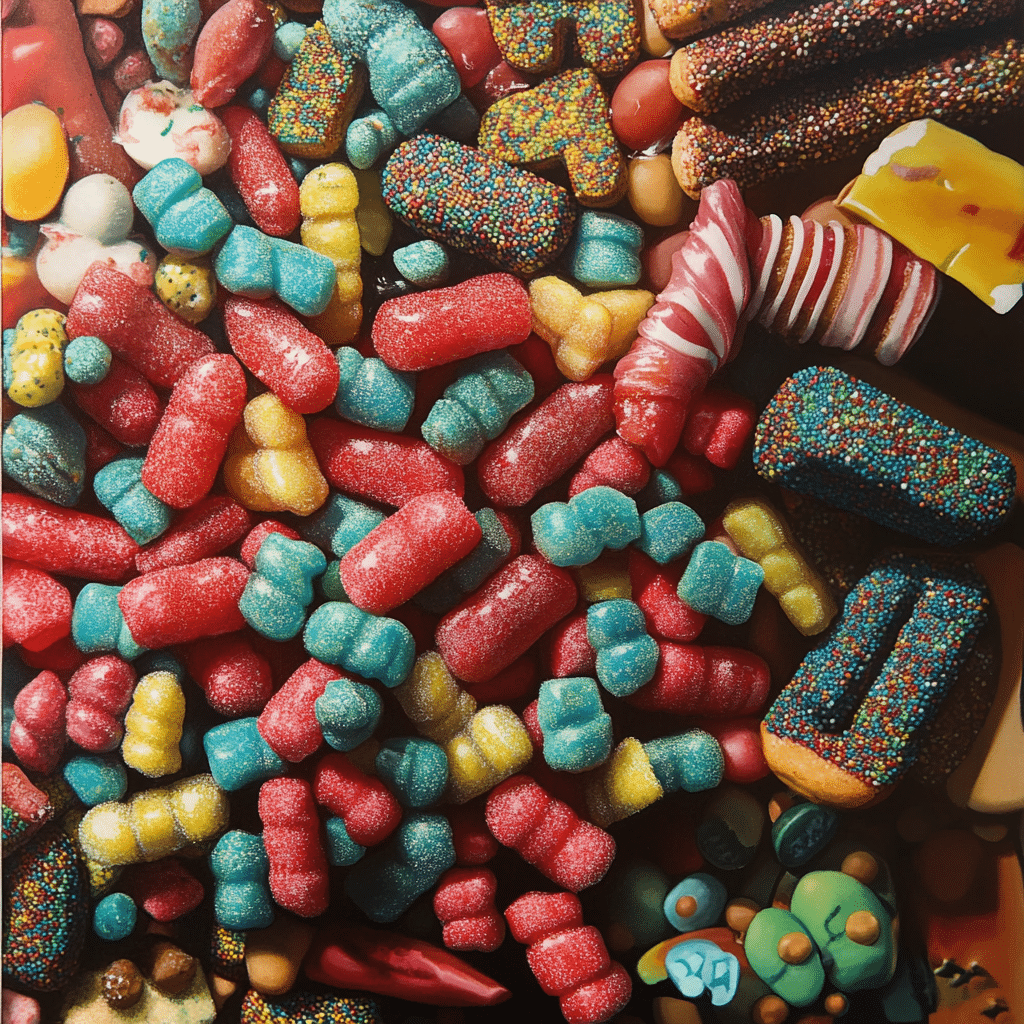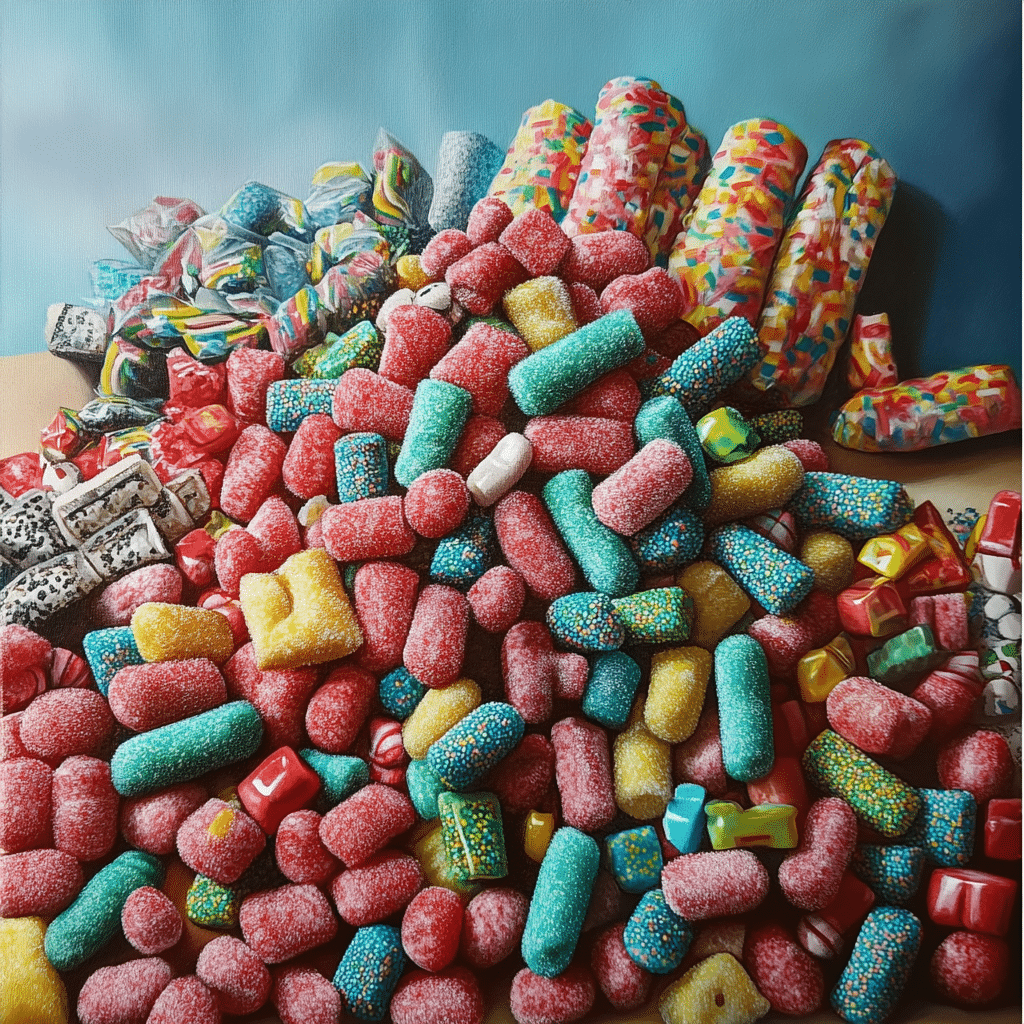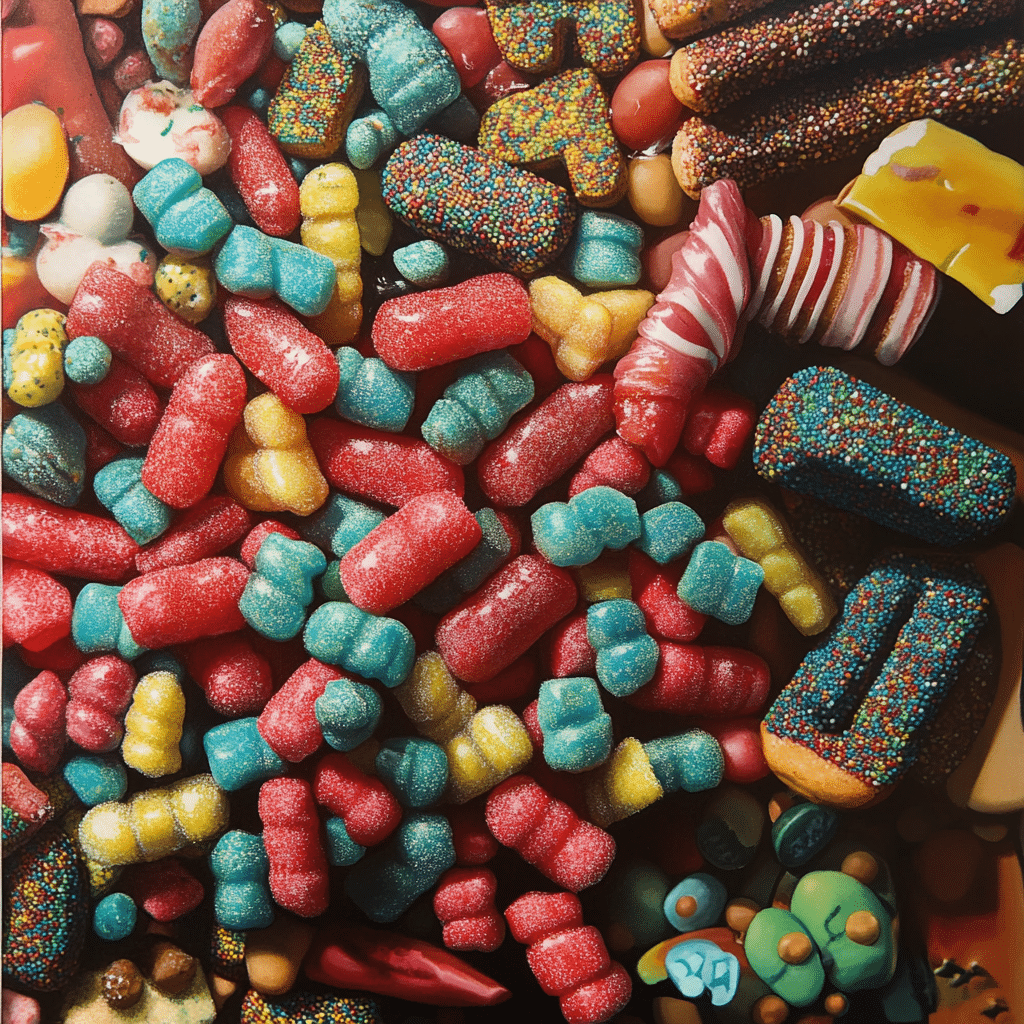In a world where processed foods dominate grocery store shelves and sweet cravings strike at all hours, sweet junk food has become more than just a guilty pleasure—it’s a cultural staple. From chewy gummies and colorful lollipops to rich chocolate bars and nostalgic no-bake treats, sugary snacks offer comfort, excitement, and flavor overload. But have you ever wondered why we love them so much—or how much sugar is really in that handful of candy?
This guide dives deep into the universe of sweet junk food: what it is, how it affects your health, why you crave it, and even how to make your own fun treats at home. Whether you’re looking to understand the science behind your sweet tooth or searching for low-sugar alternatives, we’ve got you covered.
Looking for inspiration? Try Cherry Cheesecake Puppy Chow, the ultimate no-bake delight.
Table of Contents
Table of Contents
1. What Is Sweet Junk Food?
Defining Sweet Junk Food in Today’s Diet
Sweet junk food refers to highly processed snacks that are packed with sugar and low in nutritional value. These include candies, chocolate-coated treats, pastries, sugary cereals, and artificially flavored gummies. The primary ingredient? You guessed it—refined sugar, sometimes combined with syrups, dyes, fats, and preservatives.
This type of food is typically:
- High in calories and carbohydrates
- Low in fiber, protein, and essential nutrients
- Designed for taste, convenience, and shelf life
Think of a bag of rainbow gummies, a frosted donut, or a candy bar. They’re made to light up your taste buds—not nourish your body.
Discover great ideas like Gummies & Chews for sweet indulgences.
Difference Between Junk Food and Sweets
While all sweet junk food falls under the junk food category, not all sweets are considered junk. Here’s the distinction:
| Type | Description | Junk Food? |
|---|---|---|
| Apple Pie (homemade) | Natural ingredients, moderate sugar | Not typically |
| Candy Bar | Processed, high sugar, low nutrients | Yes |
| Dark Chocolate (70%+) | Contains antioxidants, less sugar | No (in moderation) |
| Gummy Worms | Artificial flavors and colors | Yes |
| Yogurt Parfait (unsweetened) | Naturally sweet from fruit | No |
Sweet treats can be made with whole ingredients like fruit, honey, and oats, and those often aren’t considered “junk food.” It’s the industrial processing and added sugars that push certain sweets into the junk category.
Don’t miss our Chocolate & Coated Treats selection—sweet and rich!
2. The Science Behind Sugar Cravings
Why Our Brains Love Sweet Junk Food
Your love for sweet junk food isn’t just habit—it’s hardwired. When you eat sugary snacks, your brain lights up like a holiday parade. That’s because sweet junk food triggers the release of dopamine, a chemical messenger responsible for feelings of pleasure and reward.
Here’s how it works:
- Sugar activates reward pathways in the brain, similar to addictive substances.
- It causes a spike in insulin, providing a temporary energy high.
- As the spike crashes, your brain craves another hit—leading to the next cookie, candy, or cupcake.
This “sugar rush” loop is why people often feel hooked on sweets. Our brains evolved to seek out high-calorie foods, and sweet junk food is the modern version of a prehistoric fruit binge—but without the fiber or nutrients.
Research from the National Institute on Drug Abuse even suggests sugar can create patterns in the brain similar to drug addiction, especially in children and teens. That explains why it’s so hard to eat “just one” gummy bear.
The Role of Dopamine and Sugar Addiction
Dopamine is at the heart of our relationship with sweet junk food. Each bite of sugary candy sets off a wave of dopamine, creating pleasure and reinforcing the behavior. Over time, though, your brain gets used to the sugar level, so you need more of it to feel the same reward.
This cycle can lead to:
- Overeating sweet snacks
- Increased cravings throughout the day
- Less satisfaction from healthier, natural foods
In fact, studies show that people who frequently consume high-sugar diets develop a tolerance to dopamine, meaning they need more sugar to feel the same pleasure. This makes sweet junk food particularly habit-forming and hard to quit.
Even worse, children’s brains are more sensitive to dopamine, which is why marketers target them with bright packaging and cartoon-themed snacks.

3. Popular Types of Sweet Junk Food
Top 10 Iconic Sweet Junk Foods in America
America has a long-standing love affair with sweet junk food. From lunchboxes to movie theaters, these sugary treats are household staples. Here’s a list of 10 iconic favorites that define the snack aisle:
| Rank | Sweet Junk Food | Notable Ingredient |
|---|---|---|
| 1 | Reese’s Peanut Butter Cups | Sugar, peanut butter, chocolate |
| 2 | Skittles | Corn syrup, food coloring |
| 3 | Twinkies | Sugar, artificial vanilla |
| 4 | M&M’s | Chocolate, sugar shell |
| 5 | Gummy Bears | Gelatin, sugar |
| 6 | Oreo Cookies | Palm oil, sugar, cocoa |
| 7 | Cotton Candy | Pure sugar |
| 8 | Sour Patch Kids | Sugar, citric acid |
| 9 | Hostess Cupcakes | Sugar, high fructose corn syrup |
| 10 | Candy Corn | Sugar, artificial flavoring |
These sugary staples are known for their addictive textures, colors, and flavors—many offering zero nutritional benefit but maximum taste satisfaction.
Check out Gummies & Chews for more sweet tooth inspiration.
Homemade vs. Store-Bought Sweets: What’s Worse?
It might surprise you, but homemade sweets aren’t always healthier. Let’s break it down:
| Type | Pros | Cons |
|---|---|---|
| Homemade Sweets | Control ingredients, no preservatives | Can still be high in sugar and fat |
| Store-Bought Junk Food | Convenient, long shelf life | Usually ultra-processed, added chemicals |
What makes store-bought options more harmful is the combination of sugar, refined flour, artificial additives, and preservatives, often engineered to make you overeat. Meanwhile, homemade treats, while still sugary, let you choose ingredients, reduce sugar, or add in fiber (like oats or fruit).
4. The Sugar Content in Junk Foods
How Much Sugar Is Really in Your Favorite Treats?
Let’s get real—most people don’t know just how much sugar they’re consuming in sweet junk food. Here’s a chart showing actual sugar content per serving:
| Junk Food | Sugar per Serving (g) | % of Daily Limit (based on 50g/day) |
|---|---|---|
| Snickers Bar | 27g | 54% |
| Starbucks Frappuccino | 50g | 100% |
| Sour Patch Kids (1 pack) | 36g | 72% |
| Twinkie (1 piece) | 19g | 38% |
| Oreo (3 cookies) | 14g | 28% |
Even seemingly small portions can put you well over your recommended sugar intake. Combine that with multiple snacks a day, and you’re easily doubling or tripling the daily limit.
Don’t miss our Chocolate & Coated Treats for alternatives that still satisfy.
Hidden Sugars in Seemingly Healthy Snacks
Don’t be fooled by words like “natural,” “low-fat,” or “gluten-free”—many products marketed as healthy are still loaded with sugar. Here are a few culprits:
- Flavored Yogurt (can have up to 20g of added sugar per cup)
- Granola Bars (some pack more sugar than a candy bar)
- Vitamin Waters (up to 32g of sugar in one bottle)
- Fruit Snacks (basically gummy candy with a different label)
Reading the nutrition label is key. Look for hidden sugars under names like:
- High fructose corn syrup
- Evaporated cane juice
- Maltose, dextrose, sucrose
- Fruit juice concentrate
Understanding what you’re consuming helps you make more informed choices and steer away from sugar bombs dressed in “healthy” clothing.
5. Sweet Junk Food and Health Impact

Effects of Excess Sugar on the Body
Consuming sweet junk food regularly doesn’t just affect your waistline—it impacts nearly every part of your body. While an occasional treat is fine, daily indulgence in sugar-heavy snacks can lead to serious health issues:
- Weight Gain & Obesity: Sugar is high in calories but low in satiety. This means you’re likely to overeat and store more fat—especially around your belly.
- Insulin Resistance & Type 2 Diabetes: Regular spikes in blood sugar from sweets strain your pancreas, eventually making your body less sensitive to insulin.
- Tooth Decay: Sugar feeds bacteria in the mouth, producing acids that erode enamel and cause cavities.
- Skin Breakouts: High sugar intake can trigger inflammation and increase sebum production, leading to acne.
- Chronic Fatigue: After the sugar high comes the crash—causing energy dips, irritability, and brain fog.
One study published by the American Journal of Clinical Nutrition found that a diet rich in added sugars increases the risk of cardiovascular death by over 30%.
Learn more about smart candy habits with Cherry Cheesecake Puppy Chow—a sweet treat made smarter.
Link Between Junk Food and Chronic Diseases
Sweet junk food is loaded with refined sugars, saturated fats, and artificial additives—all known contributors to:
- Heart disease
- Type 2 diabetes
- Fatty liver disease
- Cancer (especially colon and breast)
- Cognitive decline and memory issues
Over time, sugar causes chronic inflammation, which weakens the immune system and accelerates disease. And since sweet junk food lacks nutrients, it replaces wholesome foods that could support your body’s natural defenses.
This makes it essential to be aware of how often you’re indulging—and to find better alternatives, which we’ll dive into next.
6. Sweet Junk Food Alternatives
Healthier Sweet Snacks You Can Try Today
Craving something sweet doesn’t mean you need to reach for a candy bar. Here are better-for-you options that still hit the sweet spot:
| Alternative | Benefit |
|---|---|
| Fresh berries with Greek yogurt | Natural sugar + protein |
| Dark chocolate (70%+) | Antioxidants, less sugar |
| Homemade fruit leather | No preservatives or added sugar |
| Frozen banana slices | Creamy and naturally sweet |
| Energy bites (dates, oats, peanut butter) | Fiber-rich |
Pro tip: Mix and match. Combine dried fruit with unsalted nuts, or drizzle honey over roasted almonds for a satisfying crunch.
Low-Sugar Candy and Dessert Options
Want to stick to candy? Try low-sugar or sugar-free options. Some great picks include:
- Stevia or monk fruit sweetened gummies
- Keto-friendly chocolate bars
- Homemade gelatin desserts with real fruit juice
- Baked apples or pears with cinnamon
Even brands are catching on and offering low-carb and sugar-free varieties that use plant-based sweeteners without the crash.
Discover great ideas like Gummies & Chews made with real juice.
7. Cultural Role of Sweet Junk Food
Why Sweet Junk Food Is Part of Celebrations
From birthday cakes to Halloween candy, sweet junk food is deeply woven into the fabric of American culture and traditions. It plays a role in:
- Celebrations and holidays: Think Valentine’s Day chocolates or Thanksgiving pies.
- Rewards and comfort: A lollipop for a good grade, or ice cream after a rough day.
- Nostalgia and family rituals: Baking cookies with grandma or summer s’mores.
While there’s nothing wrong with indulgence during special moments, the problem arises when occasional treats become daily habits.
That’s why it’s important to separate emotional eating from physical hunger.
Marketing Tactics That Hook Kids and Adults
Let’s face it: the sweet junk food industry is expert at hooking consumers—especially kids. Here’s how:
- Bright packaging and cartoon mascots
- Placement near checkout counters
- Taglines like “limited-time only”
- Commercials during kids’ programming

Studies show that children exposed to sugary food advertising are twice as likely to choose those foods later in the day.
Adults aren’t immune either. Ever walked into a store and bought candy “just because it was on sale”? That’s the power of marketing at play.
8. How to Manage Sweet Cravings
Practical Tips to Cut Back Without Going Cold Turkey
Going sugar-free overnight? That’s a recipe for frustration. Instead, reducing your intake of sweet junk food gradually can help you stay on track without feeling deprived. Here’s how:
- Swap, Don’t Eliminate
Replace candy with fruit, granola bars with protein bites, and soda with sparkling water. Small changes add up. - Drink More Water
Thirst often disguises itself as hunger. Stay hydrated to avoid sugar cravings. - Eat Regularly
Skipping meals leads to low blood sugar, triggering your body to crave fast energy—like candy. - Keep It Out of Sight
The more you see it, the more you’ll want it. Store junk food out of reach or don’t buy it at all. - Be Mindful of Triggers
Stress, boredom, and fatigue often lead to sugar binges. Recognize your emotional eating cues.
Looking for inspiration? Try homemade alternatives from our Chocolate & Coated Treats guide.
Reading Labels: Spotting the Sugar Traps
Don’t be fooled by fancy packaging. Sweet junk food often hides sugar under different names. When reading labels, watch for:
- Words ending in -ose: fructose, glucose, sucrose
- Syrups: corn syrup, malt syrup
- Other aliases: cane juice, dextrin, fruit juice concentrate
Also check the Nutrition Facts Panel:
- Aim for under 5g of added sugar per serving
- Avoid products with sugar as the first or second ingredient
Being an informed shopper is half the battle. The less sugar you unknowingly consume, the less your body will crave it.
9. DIY Sweet Junk Food Recipes
3 Simple Homemade Treats with a Junk Food Twist
Making your own sweet snacks at home puts you in control of ingredients and portions. Here are 3 delicious, DIY sweet junk food recipes that taste indulgent but don’t come with mystery chemicals.
1. No-Bake Peanut Butter Oat Balls
Tastes Like: Reese’s
- 1 cup rolled oats
- ½ cup natural peanut butter
- ¼ cup honey
- Dash of sea salt
- Optional: Dark chocolate chips
Mix, roll, and chill. That’s it. Protein, fiber, and flavor without the crash.
2. Frozen Yogurt Bites
Tastes Like: Candy chews
- Spoon Greek yogurt into ice cube trays
- Add berries or a drizzle of honey
- Freeze and enjoy
A refreshing low-sugar snack with calcium and probiotics.
3. Fruit Leather
Tastes Like: Fruit roll-ups
- Blend 2 cups fruit with 1 tbsp honey
- Spread thin on parchment paper
- Dehydrate or bake on low for 6-8 hours
A kid-friendly, additive-free version of a lunchbox classic.
Fun Candy Experiments From Your Kitchen
Channel your inner scientist and get the whole family involved with these sweet creations:
- Rock Candy Crystals: Dissolve sugar in hot water and let strings sit for a few days
- Homemade Gummies: Mix gelatin, juice, and honey in molds
- Microwave Caramel Popcorn: Sweet and salty in five minutes
These DIY treats are a great way to satisfy cravings, bond with loved ones, and cut down on ultra-processed foods.
FAQ
Is sweet a junk food?
Not all sweet foods are considered junk food. Natural sweets like fruits or dark chocolate in moderation are healthy. However, sweets loaded with refined sugar, preservatives, and artificial colors—like most candies, cupcakes, and sodas—fall into the junk food category due to their low nutritional value.
What are 10 sweet foods?
Here’s a list of sweet foods ranging from natural to processed:
- Strawberries
- Bananas
- Honey
- Chocolate bars
- Gummies
- Caramel popcorn
- Donuts
- Cotton candy
- Cupcakes
- Sweetened yogurt
What junk food has sugar?
Most junk foods contain sugar. Common examples include:
- Candy (gummies, lollipops)
- Sweetened cereals
- Pastries (donuts, cakes)
- Chocolate bars
- Ice cream
Even savory items like sauces and snack bars can have hidden sugars.
What is the most tasty junk food?
Taste is subjective, but in the U.S., popular favorites include:
- Reese’s Peanut Butter Cups
- M&M’s
- Oreo Cookies
- Twinkies
- Skittles
Their blend of sugar, fat, and flavor makes them crave-worthy and hard to resist.
Is junk food very healthy?
No, junk food is generally not healthy. It’s high in calories, sugar, and unhealthy fats while lacking fiber, protein, and essential nutrients. Long-term consumption can lead to weight gain, diabetes, heart disease, and more.
Conclusion
Sweet junk food is everywhere—from candy aisles to office desks and birthday parties. And while indulging now and then is part of the fun, understanding what goes into these sugary treats helps you make better choices. By knowing what’s hiding in your snacks, spotting the sugar traps, and trying healthier alternatives or DIY recipes, you can enjoy the sweet without all the junk.
Cravings are natural, but balance is key. So next time your sweet tooth calls, you’ll have the knowledge—and maybe even a homemade peanut butter oat ball—ready to go.
For more recipes follow me on PINTEREST

